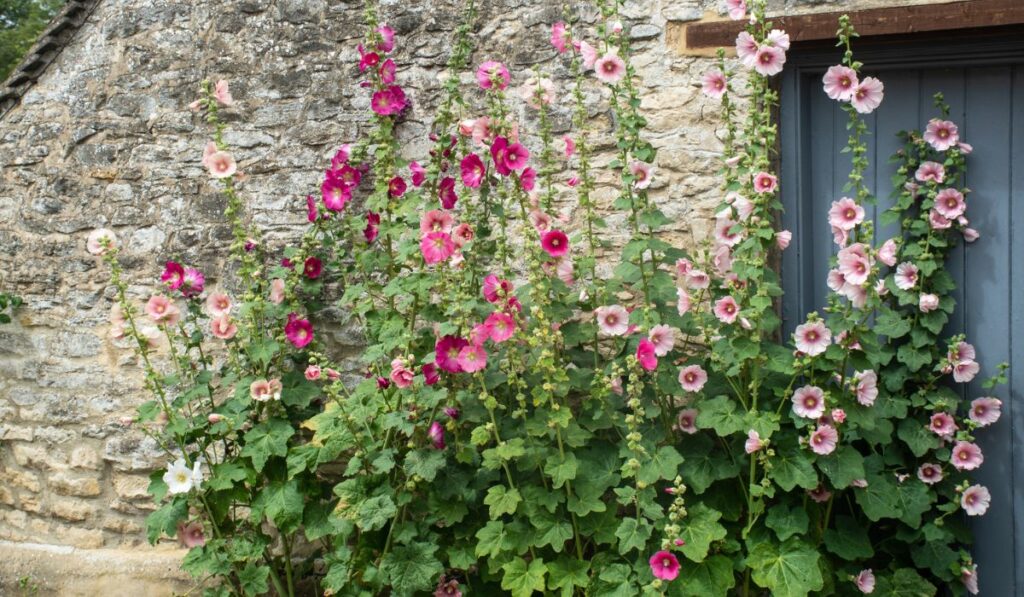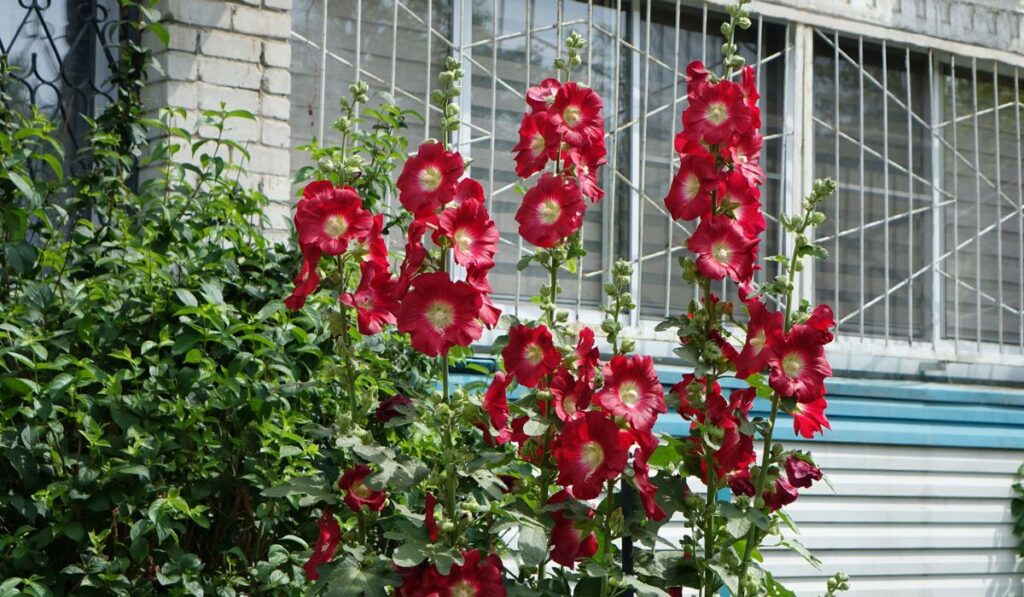Hollyhocks are one of the classic old-fashioned cottage garden flowers. They come in many beautiful colors and make a statement in the garden. If you’re planning on growing hollyhocks, here’s what you need to know about when to plant them and how to care for them.
Hollyhocks seeds are best planted in the early spring, a week before the last frost date in your area. You can start them indoors, but it’s unnecessary. Hollyhocks prefer full sun but will tolerate partial shade. In addition, they need well-drained soil rich in organic matter.
Hollyhocks are low maintenance and aren’t susceptible to many pests or diseases, making them perfect for beginner gardeners. Combined with their beautiful full blooms, it’s no wonder why hollyhocks are such a popular garden flower. So let’s find out more about when to plant hollyhock and some tips on hollyhock growing.
When Should You Plant Hollyhocks?

Hollyhocks are versatile and can be planted at different times with different methods. The normal hardiness zone for hollyhocks is 3-9.
In these zones, you can sow hollyhock seeds (on Amazon) directly into your garden bed in late spring or early summer (May to June). The best time for sowing is a week before the average last frost, with the soil temperature less than 50 Farenheight.
Starting Early
If you want a head start on the season or live in a colder climate, you can start hollyhocks indoors 8-10 weeks before the last frost. First, plant the seeds in peat pots and keep them moist and warm until they germinate. Then, you can transplant the seedlings into your garden 2-3 weeks after the last frost.
You can also purchase hollyhock plants from a nursery or online retailer. These will be ready to plant in your garden as soon as the last frost has passed.
Where is the Best Place to Plant Hollyhocks?
There are several factors to consider when planting hollyhocks, including:
Sun and Soil
Hollyhocks prefer full sun but will tolerate some partial shade, especially in hot climates. They are not particularly fussy about soil type but need good drainage to prevent root rot.
If your soil is heavy or clay-laden, you can amend it by adding compost or other organic matter. The ideal soil pH for hollyhocks is 6.0-8.0.
Height
Hollyhocks are tall plants, so they’ll need some support. You can plant them next to a fence or wall or stake them. If you live in an area with high winds, you’ll need to take extra precautions to ensure your hollyhocks don’t blow over.
Space
They also need a vast space; an average Hollyhock plant can grow 2 feet wide. However, these roots also grow deep and spread out, so you’ll need to give them enough room to breathe. This means the beds should be at least 3 feet wide.
Self Seeders
Another important consideration is that hollyhocks can self-seed. This means they will drop seeds after they flower, and new hollyhocks will grow in that spot the following year and even proliferate if given a chance.
If you’re not a regular gardener, choose a spot for your hollyhocks where they will not be a nuisance. Or you can deadhead them at the end of the season (remove the spent flowers) to prevent self-seeding.
How Deep to Plant Hollyhock Seeds?
Outdoor Sowing
If you’re directly seeding into your garden, plant the hollyhock seeds 1/4 inch deep and 6 inches apart. After germination, thin the seedlings to 12-18 inches apart. Make sure you prepare the soil a week before you plan to plant. Loosen the dirt to a depth of 12 inches and remove any rocks or debris.
If your soil is very compacted, you may need to loosen it even deeper. And ensure the ground isn’t too wet; you want it crumbly but not muddy.
To sow the seeds, make a level surface by raking the soil. Then, sow each seed individually only a quarter of an inch deep. If you’re planting more than one row, space the rows 2-3 feet apart.
Indoor Sowing
To start hollyhocks indoors, you’ll need to do it in a sowing tray or pots. First, fill the tray or pots with the compost mix, and water the compost until it’s moist; keep watering for two days before you sow the seeds.
Then put individual seeds on the surface, about five inches apart. Do not press the seeds; instead, cover them with a light layer of compost. Next, put the tray in a warm place and cover it with an empty compost bag or plastic wrap. This will help keep the humidity high and prevent the compost from drying.
Leave it for at least two weeks until the seeds have germinated. Then remove the cover and put the seedlings in a sunny spot. You can transplant them outdoors when they have developed their first set of true leaves.
What Can You Plant with Hollyhocks?
Hollyhocks make great companions for plants that share similar growing conditions. They are also tall plants, making good companions for shorter plants that might need some support. Here are some of the best plants to grow with hollyhocks:
- Nasturtiums: These cheerful annuals are perfect for filling in gaps in the garden. They have a trailing habit, so they’re ideal for planting at the base of hollyhocks.
- Peonies: Peonies bring the contrasting foliage with their lush, deep green leaves. They also make an excellent cover for the hollyhock’s bare legs in the late-season garden.
- Larkspur: Another tall cottage garden favorite, larkspur blooms in shades of blue and purple. They make a beautiful mix with hollyhocks in the summer garden.
- Phlox: Another great option for filling out the garden. Phlox comes in various colors, so you can find the perfect match for your hollyhocks.
- Fountain Grass: If you want green companions for your hollyhocks, try something like fountain grass. The variegated leaves add interest to the garden, and the mounded habit helps fill empty spaces.
- Bellflower: A plant that shares the love of the sun and well-drained soil with hollyhocks.
- Cactus zinnias: If you want to add height and drama to your garden, try tall cactus zinnias. These annuals can give hollyhocks a run background.
- Yarrow: Another hardy perennial, yarrow comes in a variety of colors. It’s an excellent choice for the front of the border or as a ground cover.
- Sunflower: Everyone’s favorite summertime annual sunflowers make a great companion for hollyhocks. They provide some height and interest in the garden, and their large leaves can help shade hollyhocks in the summer heat.
- Delphiniums: These tall, stately plants make a great background for hollyhocks. They come in various colors, so you can mix and match them to create your perfect cottage garden.
- Rose Marrow: A perfect plant for planting in the full sun, rose marrow is a heat-tolerant annual that will add color and interest to your garden.
- Marigold: One of the most popular annuals, marigolds can line around the border of your Hollyhock beds.
How Much Space do Hollyhocks Need?

Hollyhocks are beautiful cottage garden plants that add height, color, and interest to the garden. These tall plants can reach up to eight feet and spread about two feet. So, when planning your garden, give them enough space to grow.
Three feet around each plant is usually sufficient to let them grow without crowding out other plants in the garden. But if you want a hedge or thick border of hollyhocks, you can plant them closer together at about two feet apart. Then thin them out if they start to crowd each other.
If you’re planting multiple rows of hollyhocks, space them three to four feet apart. This will give you enough room to walk between the rows for cleaning and maintenance without damaging the plants.
Choose a pot at least 12 inches wide and deep if you’re growing them in containers. Hollyhocks have long taproots and some lateral growth, so they need a deep pot to accommodate that.
How Often do Hollyhocks Need Water?
Hollyhocks are not drought tolerant, but mature plants can somewhat tolerate dryness. However, these plants need about an inch of water per week from rainfall or irrigation.
So when seedlings or young plants are getting established, water them more frequently to ensure they have enough moisture. Make sure the soil remains moist but not soggy.
Once they are mature, Hollyhocks need less water, only once or twice a week. Water deeply from below as wetting the leaves makes it more susceptible to fungal diseases.
During periods of extended drought or if you live in an area with high heat and humidity, you may need to water your hollyhocks more frequently. Whenever the leaves start to wilt, that’s a sign that the plant is thirsty and needs a drink.
Can Hollyhocks Survive Frost?
Hollyhocks are hardy plants, which means they can tolerate a light frost. However, the plant will be damaged if the temperature drops below freezing. Therefore, if you live in an area with harsh winters, it’s best to grow hollyhocks as annuals.
For slightly warmer climates, you’ll need to deadhead the plant and cover it with mulch in the winter. This will protect the roots from the cold and help the plant to regrow in the spring.
Other than that, if you’ve bought a Hollyhock plant from a nursery, it might not be adequately hardened off to survive in your garden yet. In this case, it’s best to keep them in a pot and slowly acclimate them to the outdoors by keeping them outside during the day and bringing them back at night for a week or two.
Hollyhocks aren’t an option for places with permafrost as a garden plant. It’s best to plant them in pots and keep them in a greenhouse or sunny windowsill indoors.
How do You Winterize Hollyhocks?
Winterizing hollyhocks is a process of protecting the plant from the cold weather. This is different for different environments.
Warmer Places
In warmer zones (5-9), hollyhocks are considered perennials. They don’t need to be winterized, but you may want to deadhead the plant in the fall to tidy up the garden.
For that prune, the plant down to about 6-18 inches after the blooms have faded and leave the stalks through the winter. This will help to protect the plant from rust fungus that can overwinter on the plant.
Colder Places
In colder zones (3-5), hollyhocks need protection from the cold weather. Cut the Hollyhock stem near the base, about 5-6 inches from the ground. Cover the plant with a layer of mulch, compost, and litter leaves over the base.
Make sure it’s at least 6 inches thick, so the plant is well protected. Start removing the mulch in early spring when the weather starts to warm up. Once you see new growth, you can remove the insulation but stay aware of any late frosts that might come. If it happens, quickly cover the plant again with the mulch.
For even harder climates, it’s best to grow hollyhocks in pots so you can move them indoors in the winter. Alternatively, you can try growing them as annuals.
